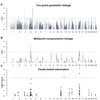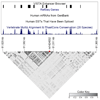Identification of two common variants contributing to serum apolipoprotein B levels in Mexicans
- PMID: 19965785
- PMCID: PMC2809779
- DOI: 10.1161/ATVBAHA.109.196402
Identification of two common variants contributing to serum apolipoprotein B levels in Mexicans
Abstract
Background and purpose: Although the Mexican population has a high predisposition to dyslipidemias and premature coronary artery disease, this population is underinvestigated for the genetic factors conferring the high susceptibility. This study attempted to determine these genetic factors.
Methods and results: First, we investigated apolipoprotein B (apoB) levels in Mexican extended families with familial combined hyperlipidemia using a two-step testing strategy. In the screening step, we screened 5721 single-nucleotide polymorphisms (SNPs) for linkage signals with apoB. In the test step, we analyzed the 130 SNPs residing in regions of suggestive linkage signals for association with apoB. We identified significant associations with two SNPs (ie, rs1424032 [P=6.07x10(-6)] and rs1349411 [P=2.72x10(-4)]) that surpassed the significance level for the number of tests performed in the test step (P<3.84x10(-4)). Second, these SNPs were tested for replication in Mexican hyperlipidemic case-control samples. The same risk alleles as in the families with familial combined hyperlipidemia were significantly associated (P<0.05) with apoB in the case-control samples. The rs1349411 resides near the apoB messenger RNA editing enzyme (APOBEC1) involved in the processing of APOB messenger RNA in the small intestine. The rs1424032 resides in a highly conserved noncoding region predicted to function as a regulatory element.
Conclusions: We identified two novel variants, rs1349411 and rs1424032, for serum apoB levels in Mexicans.
Conflict of interest statement
No conflicts to disclose
Figures



References
-
- Goldstein JL, Hazzard WR, Schrott HG, Bierman EL, Motulsky AG. Genetics of hyperlipidemia in coronary heart disease. Trans Assoc Am Physicians. 1972;85:120–138. - PubMed
-
- Chait A, Albers JJ, Brunzell JD. Very low density lipoprotein overproduction in genetic forms of hypertriglyceridaemia. Eur J Clin Invest. 1980;10:17–22. - PubMed
-
- Sveger T, Nordborg K. Apolipoprotein B as a marker of familial hyperlipoproteinemia. J Atheroscler Thromb. 2004;11:286–292. - PubMed
-
- Pajukanta P, Nuotio I, Terwilliger JD, Porkka KV, Ylitalo K, Pihlajamaki J, Suomalainen AJ, Syvanen AC, Lehtimaki T, Viikari JS, Laakso M, Taskinen MR, Ehnholm C, Peltonen L. Linkage of familial combined hyperlipidaemia to chromosome 1q21-q23. Nat Genet. 1998;18:369–373. - PubMed
-
- Naoumova RP, Bonney SA, Eichenbaum-Voline S, Patel HN, Jones B, Jones EL, Amey J, Colilla S, Neuwirth CK, Allotey R, Seed M, Betteridge DJ, Galton DJ, Cox NJ, Bell GI, Scott J, Shoulders CC. Confirmed locus on chromosome 11p and candidate loci on 6q and 8p for the triglyceride and cholesterol traits of combined hyperlipidemia. Arterioscler Thromb Vasc Biol. 2003;23:2070–2077. - PubMed
Publication types
MeSH terms
Substances
Grants and funding
LinkOut - more resources
Full Text Sources
Miscellaneous

